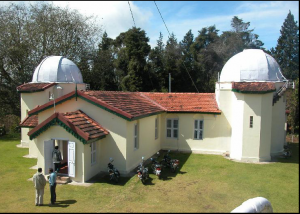ForumIAS announcing GS Foundation Program for UPSC CSE 2025-26 from 19 April. Click Here for more information.
Source– This post on 125 years of Kodaikanal Solar Observatory is based on the article “125 years of Kodaikanal Solar Observatory: How the Great Drought of 1876 led to its establishment” published in “The Indian Express” on 2nd April 2024.
Why in the News?
This year (2024) marks the 125th Year of the Kodaikanal Solar Observatory (KoSO).
What is Kodaikanal Solar Observatory (KoSO)?

1. About– It is a solar observatory owned and operated by the Indian Institute of Astrophysics.
2. Origin– The concept of an Indian solar observatory began in the late 19th century, and the government approved the establishment of the Solar Physics Observatory in Kodaikanal in August 1893.
3. Location– Kodaikanal in the Palani hills of Tamil Nadu was picked for the observatory because of its good atmospheric conditions, based on surveys by Charles Michie Smith (a Professor of Physics at the Madras Christian College).
4. Foundation- Lord Wenlock, the Governor of Madras at the time, laid the foundation stone for KoSO in 1895.
5. Systematic observations at KoSO commenced on March 14, 1901.
6. Instruments at KoSO– Initially, KoSO had telescopes to study sunspots, prominences, and solar radiation. Now, it has advanced instruments like the H-alpha telescope and the White Light Active Region Monitor (WARM) for high solar imaging.
What is the need for such observatory?
1. Great Drought of 1875-1877– The event, caused by low rainfall, highlighted the need for thorough solar studies to understand its effects on weather patterns.
2. India’s Geographical significance– India’s drought was part of a broader global issue, impacting multiple countries and resulting in widespread famine.
Significant achievements of KoSO
1. The observatory played a crucial role in solar physics, such as identifying the radial motion of sunspots, referred to as the Evershed Effect.
2. Over the years, KoSO broadened its research scope to encompass cosmic rays, radio astronomy, ionospheric physics, and stellar physics.
| Additional facts 1. During its early years, the Bhavnagar Telescope, named after the Maharaja of Bhavnagar, stood out as one of KoSO’s notable instruments. 2. A 15cm telescope was employed to photograph solar images onto film or plates, enabling the recording of solar magnetic plages and prominences since 1911. |
UPSC Syllabus- Science & Technology




